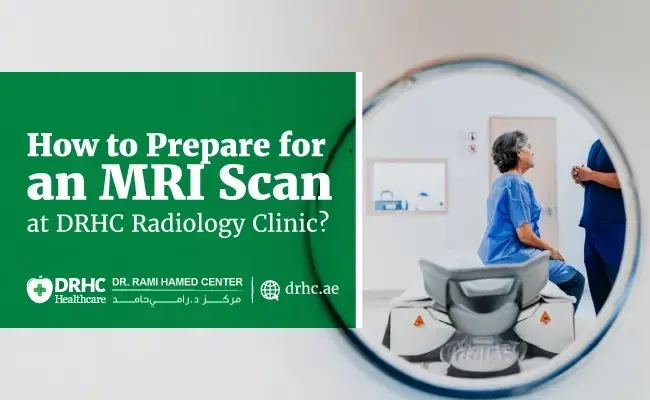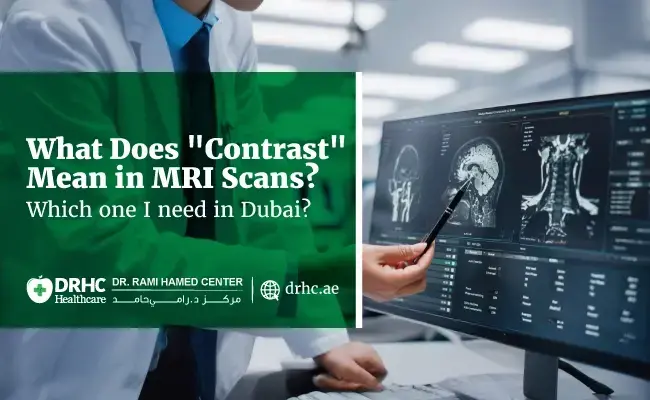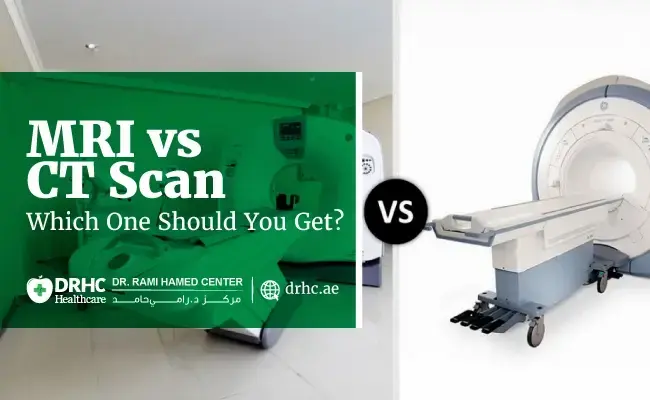
When facing a potential liver tumor diagnosis, it’s natural to feel uncertain or even fearful. You may have questions about the tests involved, what the results mean, and what the next steps will look like. One of the most advanced tools in liver imaging today is Dynamic MRI—a specialized scan that offers detailed insights to help detect, evaluate, and monitor liver tumors with precision.
At Dr. Rami Hamed Center (DRHC) in Dubai, we prioritize not only accurate diagnosis but also your comfort and confidence throughout the process. Here’s what you need to know about how a Dynamic MRI works, when it’s used, and how it supports your care journey.
What Is a Dynamic MRI?
Dynamic MRI (also known as dynamic contrast-enhanced MRI) is an advanced imaging technique that evaluates blood flow through liver tissue over time using a contrast dye. This allows radiologists to observe how liver lesions absorb and release the dye during different phases—arterial, portal venous, and delayed.
This dynamic approach helps distinguish between different types of liver lesions, such as:
- Benign lesions (like hemangiomas or cysts)
- Malignant tumors (like hepatocellular carcinoma or liver metastases)
By tracking how a liver mass responds to contrast at various stages, dynamic MRI provides valuable information that static images might miss.
Why Is Dynamic MRI Important for Liver Tumors?
The liver has a unique blood supply system, and tumors often have abnormal blood flow patterns. A standard MRI can show the size and shape of a lesion, but a dynamic MRI adds critical information about how it behaves, which is key for:
- Differentiating between benign and malignant tumors
- Staging liver cancer
- Guiding biopsy or treatment planning
- Monitoring changes over time in known liver lesions
This is especially important for patients with chronic liver conditions such as cirrhosis or hepatitis, where the risk of liver cancer is higher.
When Might a Doctor Recommend Dynamic MRI?
Your doctor may recommend a dynamic MRI if:
- You’ve had abnormal liver function tests
- An ultrasound or CT scan has revealed a suspicious liver mass
- You have a history of liver disease or cancer
- You're under surveillance for known liver nodules
At DRHC Dubai, our liver specialists and radiology team work closely together to ensure the right imaging is used based on your unique needs.
What Happens During a Dynamic MRI?
We understand that undergoing an MRI can feel intimidating, especially when cancer is a concern. Knowing what to expect can ease those worries.
Here’s what the procedure typically involves:
- Preparation: You may be asked to avoid eating for a few hours before the scan. Our team will review your health history, including kidney function, before administering contrast.
- Contrast injection: A contrast dye is injected through a small vein in your arm during the scan. This dye helps highlight blood vessels and lesions in the liver.
- Imaging in phases: The MRI captures images at several key time points (before contrast, during arterial, portal, and delayed phases) to observe how the liver and any lesions respond.
- Duration: The scan takes approximately 30 to 60 minutes.
- Comfort: You’ll lie on a padded table inside the MRI machine. The scan is painless, and our staff ensures a calming environment throughout.
Are There Any Risks or Side Effects?
Dynamic MRI is a very safe procedure for most people. The contrast dye used (gadolinium) is generally well tolerated. Rare side effects include mild allergic reactions or, in people with severe kidney disease, a condition called nephrogenic systemic fibrosis (NSF). Rest assured, our team at DRHC carefully evaluates every patient for safety beforehand.
Explore Our Related Blogs
- Signs You Might Have a Brain Aneurysm – And Why MRA Can Help
- Can Brain MRI Detect Early Alzheimer’s or Dementia?
- Breast MRI or Mammogram – Which Is Better for You?
- Can MRI Detect Pancreatic Cancer Early?
FAQs – Your Common Questions Answered
1. Is the MRI machine noisy or claustrophobic?
Yes, MRIs can be noisy, but ear protection is provided. If you’re anxious in enclosed spaces, let us know—we can help you feel more comfortable or explore alternatives if needed.
2. Do I need a referral for a dynamic MRI?
In most cases, yes. A referral ensures that the scan is appropriate for your specific condition and that the results are interpreted in the proper clinical context. DRHC Dubai offers specialist consultations to guide this process.
3. Can I go home immediately after the scan?
Yes. There is no recovery time required unless you were given a sedative (which is rare). You can return to your normal activities right after the scan.
4. How long does it take to get results?
At DRHC Dubai, our radiologists typically review and report dynamic MRI findings within 24–48 hours. Your referring doctor will then explain the results and next steps.
5. Is dynamic MRI better than a CT scan for liver tumors?
Each imaging method has its strengths. Dynamic MRI provides superior soft tissue detail and avoids radiation, making it ideal for certain liver lesions. In some cases, both MRI and CT may be used for a comprehensive assessment.
Final Thoughts: Early, Accurate Diagnosis Makes a Difference
If you or a loved one is facing uncertainty about a liver lesion or tumor, know that you’re not alone—and that technology like dynamic MRI can offer clarity. Early and precise imaging plays a key role in choosing the best treatment and improving outcomes.
At Dr. Rami Hamed Center (DRHC) in Dubai, we combine advanced imaging technology with expert, compassionate care. Whether you need an initial evaluation or a second opinion, we’re here to guide you with knowledge, support, and reassurance every step of the way.
To schedule a consultation or MRI scan at DRHC Dubai, contact us today. Your health and peace of mind are always our top priorities.
📞 +971 4 279 8800
🌐 www.drhc.ae
📍 Dubai Healthcare City, Building 52









Leave a comment